MARIANI’S
Virtual Gourmet
September
6, 2015
NEWSLETTER
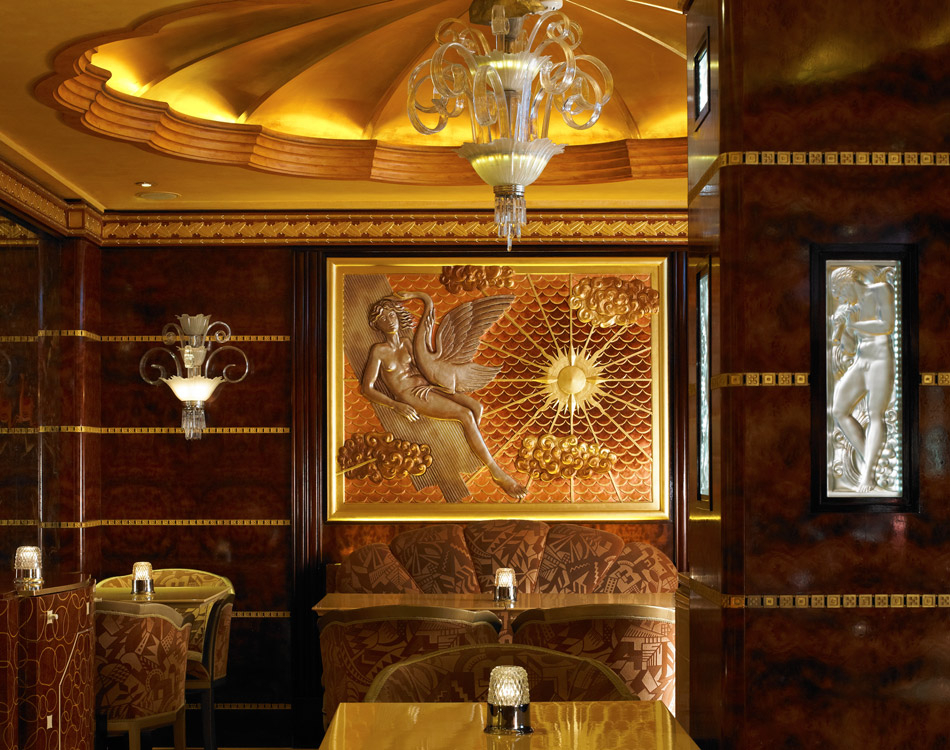
❖❖❖
IN THIS ISSUE
DINING OUT IN LONDON, Part Two
THE RITZ
By John Mariani
NEW YORK CORNER
LA PECORA BIANCA
By John Mariani
NOTES FROM THE WINE CELLAR
WHITE BORDEAUX FINALLY
GET THEIR SPOTLIGHT
By John Mariani
❖❖❖
DINING OUT IN LONDON, Part Two
THE RITZ
By John Mariani
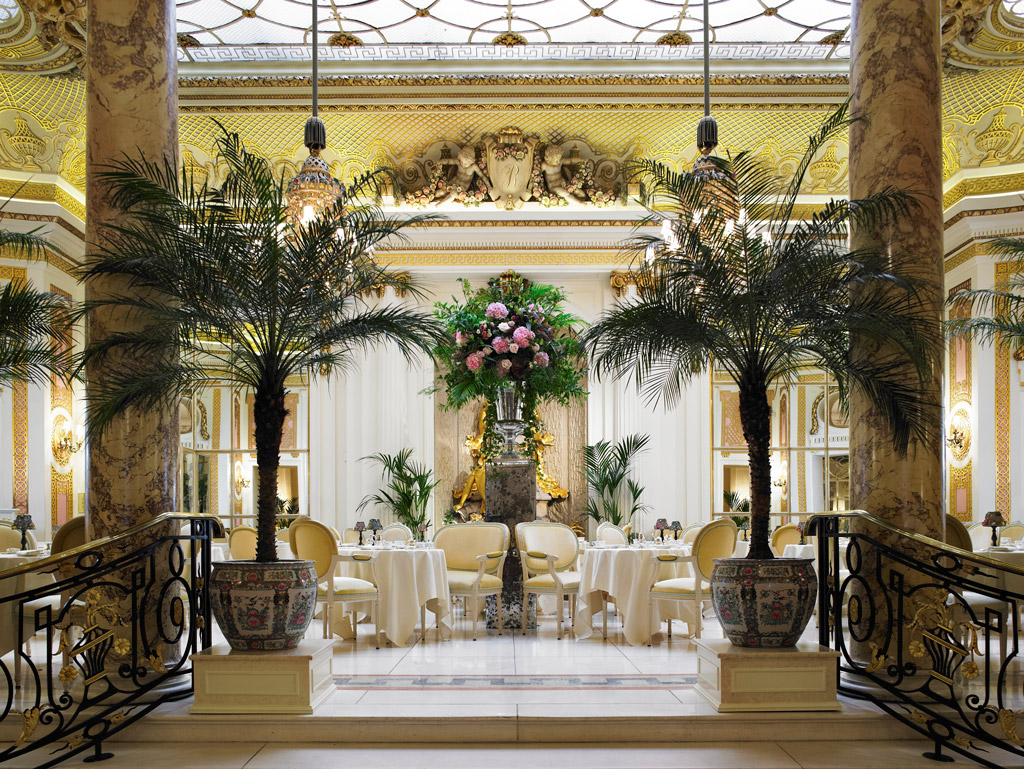
It’s
been
a hundred and nine years since The Ritz London
opened its doors on Piccadilly, its named derived
from the Swiss maestro of the era’s hoteliers,
César Ritz, which he lent to others (though none
of the present Ritz-Carlton hotels is in any way
associated, nor, any longer, are The Ritz in Paris
and Madrid).
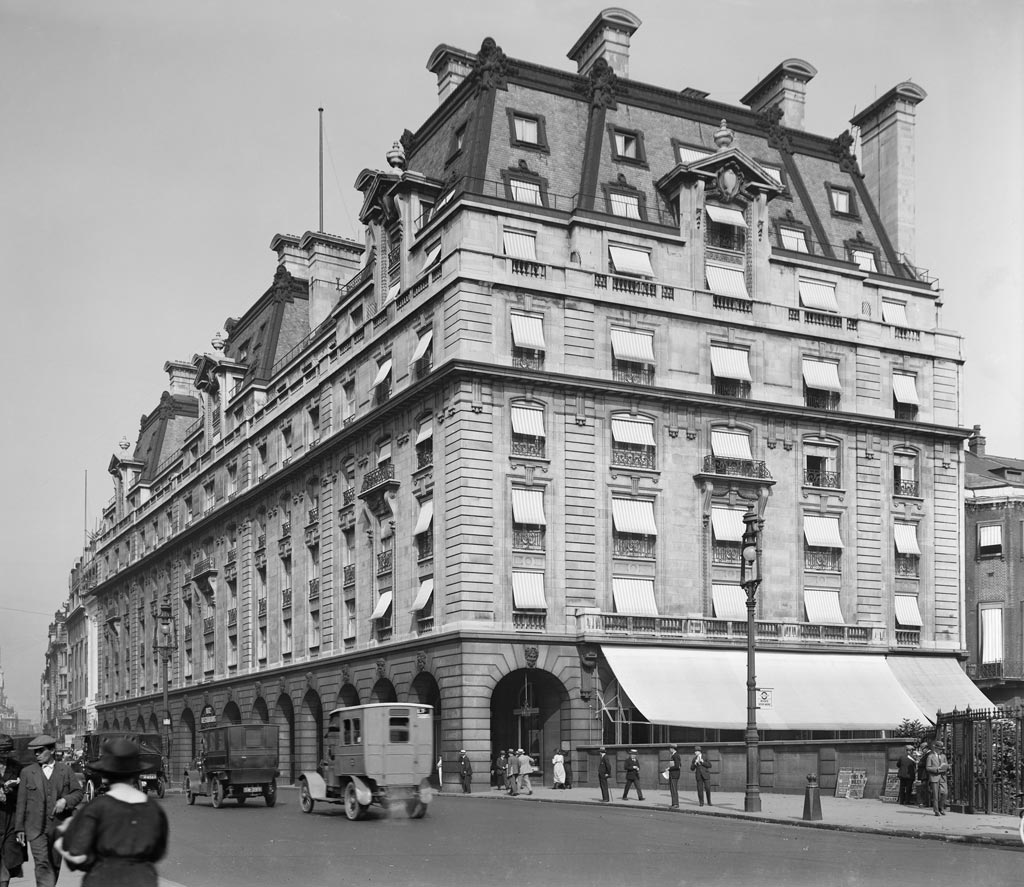 The
block-long hotel--the city’s first significant
steel-framed building, in a French château
style--was designed by Frenchman Charles Mewés and
Englishman Arthur Davis, and it was to have
innovations like bathrooms for every guest room,
double glazing, Louis XVI furnishings, and brass
beds. The
iconic copper lions guard the corners of The Ritz’s
roof. Of
particular notice was the creation of the hotel’s
Long Gallery extending from its revolving doors to
the windows of The Ritz Restaurant and overlooking
Green Park. The
exquisite Palm Court (above) became London’s premier
venue for Afternoon Tea (£50).
The
block-long hotel--the city’s first significant
steel-framed building, in a French château
style--was designed by Frenchman Charles Mewés and
Englishman Arthur Davis, and it was to have
innovations like bathrooms for every guest room,
double glazing, Louis XVI furnishings, and brass
beds. The
iconic copper lions guard the corners of The Ritz’s
roof. Of
particular notice was the creation of the hotel’s
Long Gallery extending from its revolving doors to
the windows of The Ritz Restaurant and overlooking
Green Park. The
exquisite Palm Court (above) became London’s premier
venue for Afternoon Tea (£50).
This article would double in length if I
listed all the celebrated names who signed the guest
book at The Ritz, from Noël Coward and Charlie
Chaplin to just about every member of European
royalty. Adjoining
the hotel is the 1740s Winborne House (now the Kent
House, named after its architect) in an Italian
Renaissance style, with rooms for very special
occasions and stay-overs.
The Ritz
upon opening in 1906
Although
upkeep
at The Ritz has always been steady, its purchase in
1995 by the Ellerman Group for £80 million, and £40
million more for renovation, has
restored every historic
detail to mint condition while every modern
amenity has been added to the 133 rooms (with 15
suites, each with its own butler), now largely
done in a palette of salmon pink, rose pink,
yellow and blue, with curtains of Jacquard and
damask silks.
The size and comfort of the bed pillows
alone are enough to keep you in bed long past
breakfast, but then you would miss a very splendid
first meal of the day.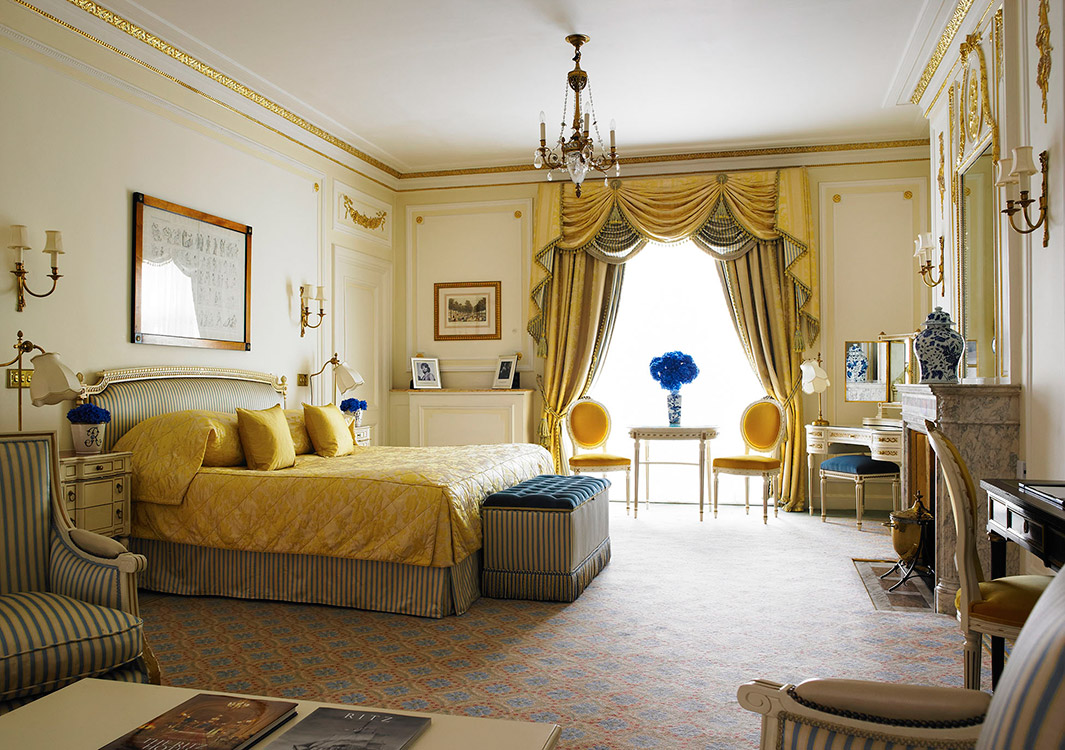
WiFi and internet access is ubiquitous, with
complimentary use of laptops on request. There is a
ladies’ salon and a men’s barber, a private club
with its own restaurant, and a Casino. And while so
many other hotels have now chosen to charge guests
for a shoe shine, The Ritz resolutely does not—how
uncongenial it would be to charge a man to have his
shoes polished!
Not without reason, The
Ritz Restaurant (below)
has been called the most beautiful in the world, and
it’s hard to argue the point, with its vast yet
welcoming size, crystal chandeliers, huge mirrors,
gilt bronze garlands, veined marble and thick
carpets. Just striding up to the room through the
grand corridor makes you straighten up and stick out
your chest.
At night the dining room is a magical place,
but when the hazy sun pours into the room at midday,
it reveals all its breathtaking detail and color. The
service, at any hour, by a brigade of veteran
captains, sommeliers and waiters, could fill a
good-sized textbook on manners without pretense, a
manner perfected by a crew largely made up of
Italians and other continentals, overseen by manager
Luigi Cagnin.
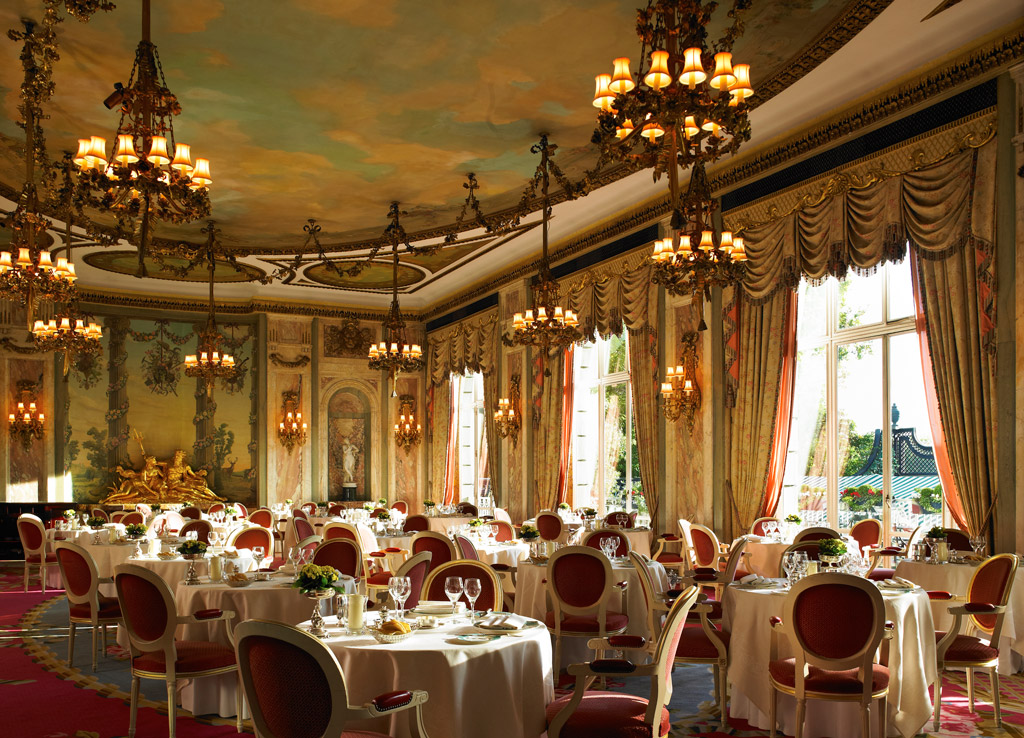 The Ritz’s reputation for
being fuddy-duddy vanished long ago, so it was odd
to hear a sophisticated London friend of mine joke
that my wife and I would be the only ones in the
dining room on a Sunday night. To our
delight, when we arrived, the room was packed with
well-dressed guests having an obviously happy
evening. I’m
glad we’d made a reservation.
The Ritz’s reputation for
being fuddy-duddy vanished long ago, so it was odd
to hear a sophisticated London friend of mine joke
that my wife and I would be the only ones in the
dining room on a Sunday night. To our
delight, when we arrived, the room was packed with
well-dressed guests having an obviously happy
evening. I’m
glad we’d made a reservation.
Eleven-year Executive
Chef John Williams (below) has carte blanche to find,
buy and serve the finest ingredients possible in the
London markets, from glorious British Isles seafood
to British beef and dairy. The menu, once of a highly
dated style, is now brilliantly balanced with
classic British and French dishes allied with
flavors as contemporary as any in London right now. The best
way to appreciate all of it is the six-course “Menu
Surprise” of Williams’s signature dishes (£95, with
wines £165), or the strongly classic “Les Arts de la
Table” menu that brings the wait staff to your table
for the nearly lost art of carving and plating. 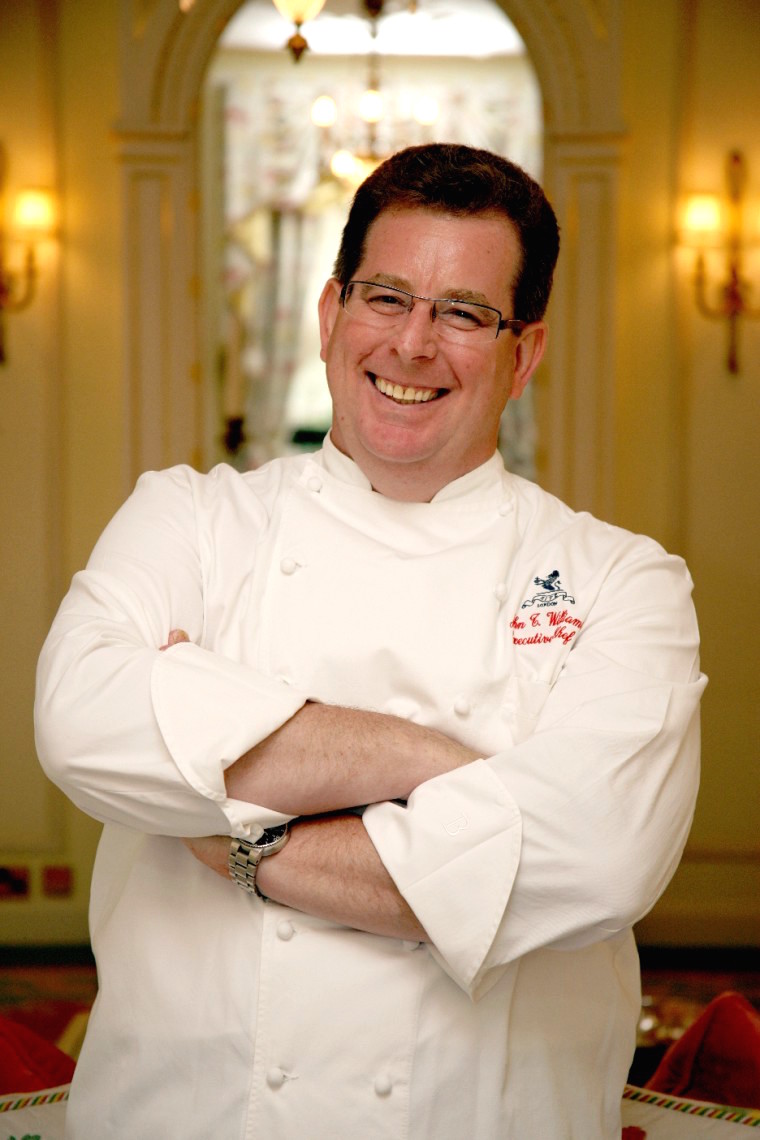 On
Friday and Saturday evenings, “Live at The Ritz”
offers a very popular four-course dinner and dancing
to live music (£95).
It is to be expected, and applauded, then,
that The Ritz is the single restaurant in London
that still requires gentlemen to wear a jacket and
tie. Don’t
even think of crashing the room without them.
On
Friday and Saturday evenings, “Live at The Ritz”
offers a very popular four-course dinner and dancing
to live music (£95).
It is to be expected, and applauded, then,
that The Ritz is the single restaurant in London
that still requires gentlemen to wear a jacket and
tie. Don’t
even think of crashing the room without them.
The wine list, overseen by head sommelier
Giovanni Ferlito, has had a century to grow fat and
deep, now with a global reach it once lacked.
We began our evening with several whimsical amuses (below) that
included an Oreo cookie-like black shortbread with goat’s
cheese and citrus gel; smoked salmon mousse, creamed
cheese and lemon macaroon topped with keta roe;
and a “Coronation Chicken” spiced tuile made from
crisp chicken skin.
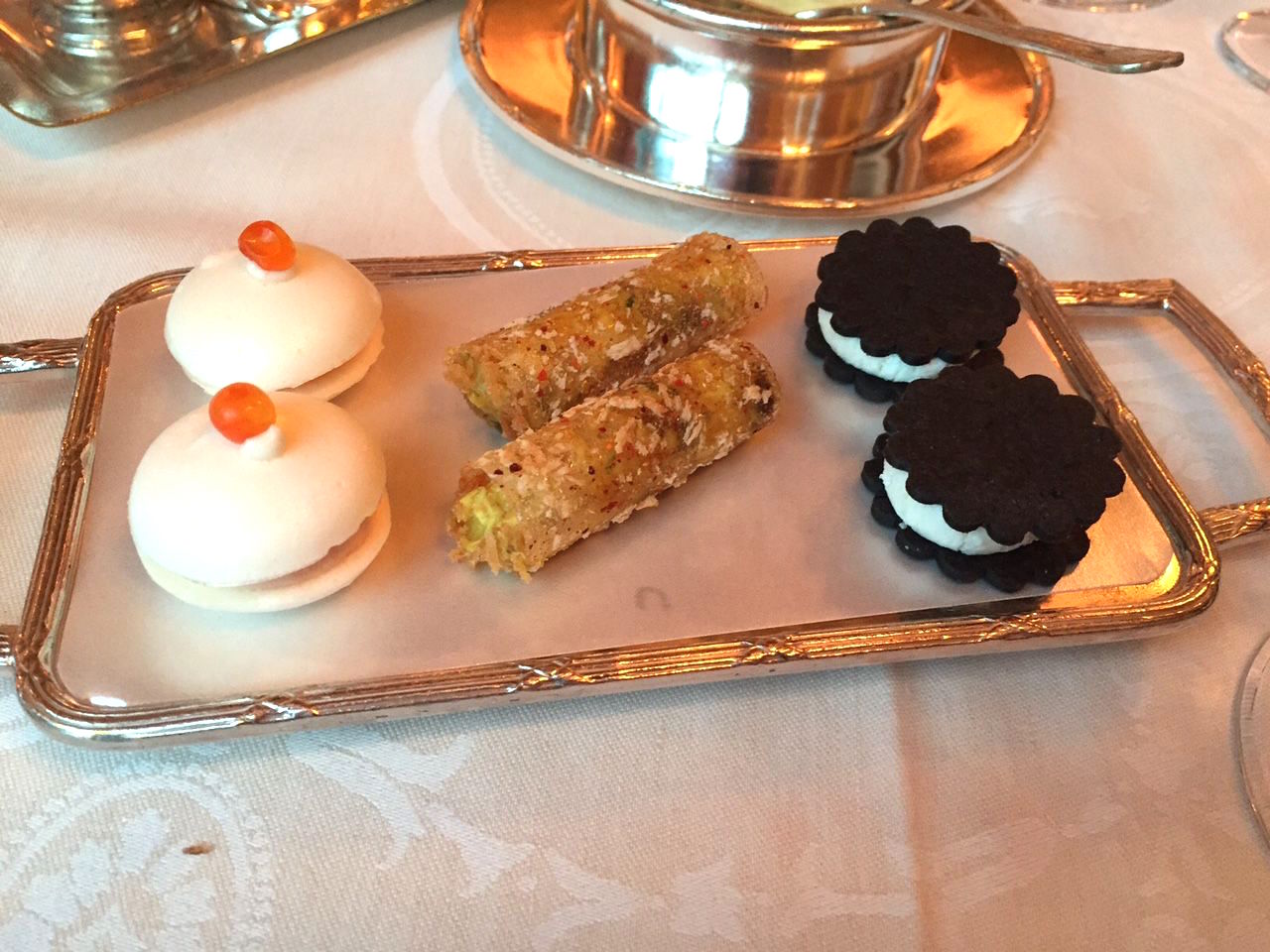 As
an appetizer a fat langoustine (£24) was simply
grilled and served with mint, black garlic and the
sweetest peas in town, with which we enjoyed a Cuvée
113 Sauska Tokaj 2011. Terrine of silky goose liver
came with spiced pineapple and gingerbread (£24),
very English colonial in its tastes, with a
José Pariente Rueda Sauvignon Blanc Dulce 2012.
As
an appetizer a fat langoustine (£24) was simply
grilled and served with mint, black garlic and the
sweetest peas in town, with which we enjoyed a Cuvée
113 Sauska Tokaj 2011. Terrine of silky goose liver
came with spiced pineapple and gingerbread (£24),
very English colonial in its tastes, with a
José Pariente Rueda Sauvignon Blanc Dulce 2012.
Williams
does
not need to add notes on the provenance of his
ingredients because he would never serve any but the
best obtainable. You certainly don’t have to guess
the pedigree of his superb loin of lamb with
caramelized shallot, mint and peas
(£38) to know it was from
a noble British breed. Tender, fatted pigeon had a
classic celery, apple and truffle sauce
(£37) that was perfect
for the slight gaminess of the bird. These
main courses were served with a Viña Tondoñia
Reserva Rioja 2002, whose age was a boon to the
cuisine.
There is a selection of British cheeses as
well as impeccably wrought traditional desserts like
lemon tart with raspberries and meringue (£14) and a
hazelnut semifreddo
(£17) with chocolate and vanilla, ending 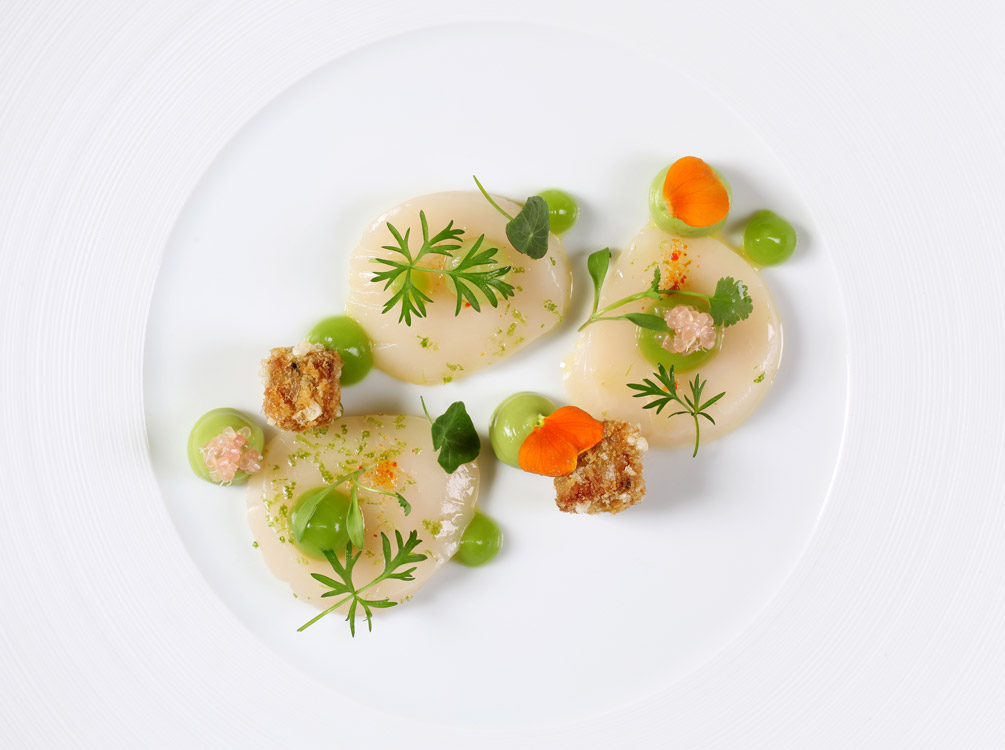 off the
evening with petits fours and chocolate.
off the
evening with petits fours and chocolate.
The prices on The Ritz menu are not
cheap--how could they be for all this grandeur?--but
neither are they out of line with restaurants of
this high degree anywhere. Add in the amuses and
petits-four, with both tax and service included in
the dish prices, and a three-course meal will run
you about £80, less than a similar meal at Alain
Ducasse at The Dorchester and The Square, which
charge £95. The
Ritz offers six courses for £95; Gordon Ramsay
offers seven for £175.
The
experience of dining at The Ritz puts into
perspective the price of haute cuisine with a
distinctly British touch, albeit with Italian
waiters. It
also gives you a good dose of tradition with a touch
of royal flourish, neither stilted nor faux, virtues
that will always make a stay at The Ritz unique in
its appeal.
By John Mariani
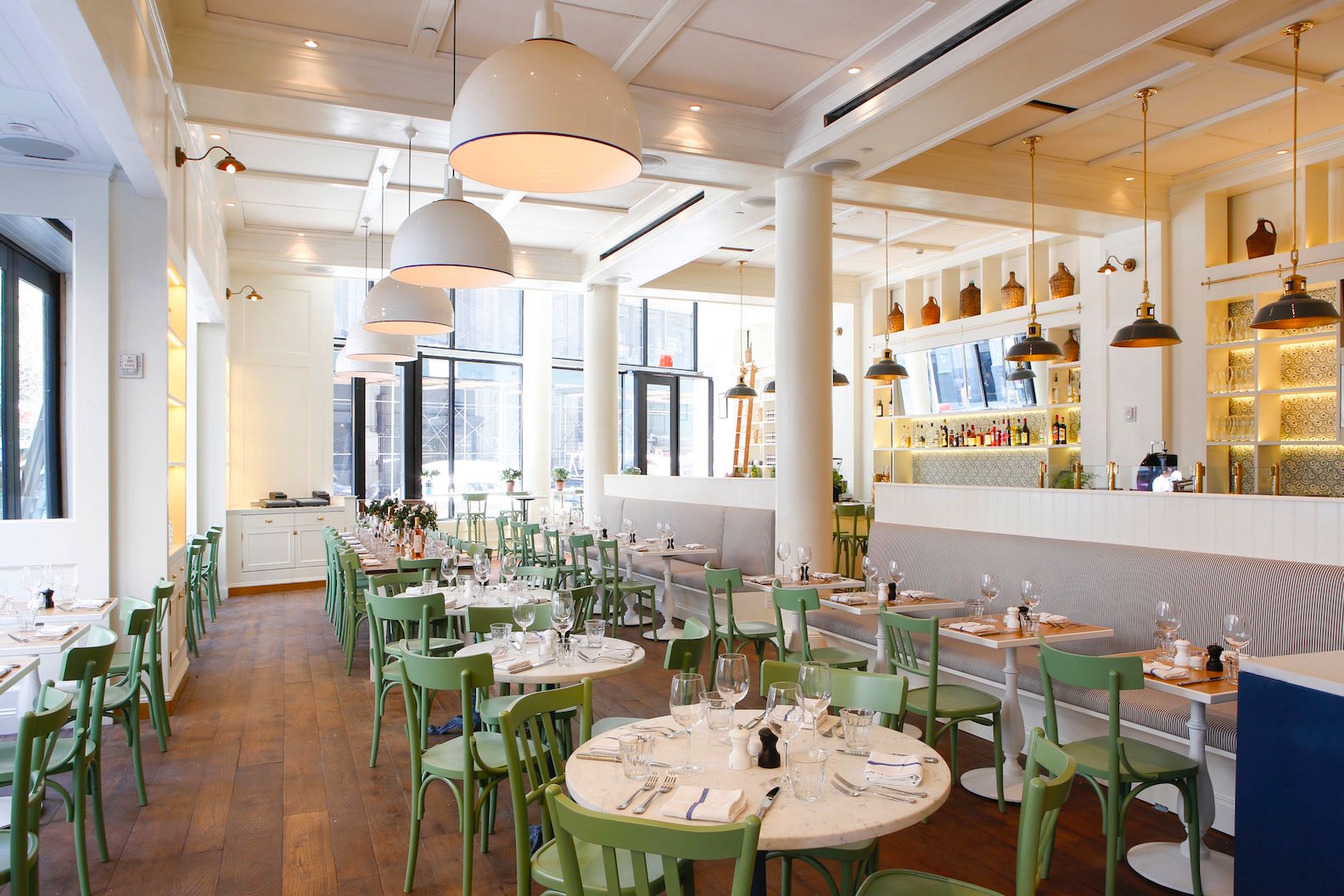 LA PECORA
BIANCA
LA PECORA
BIANCACAFFÉ E CUCINA
1133
Broadway (at
26th Street)
212-498-9696
http://lapecorabianca.com
NYC certainly has no lack of great Italian ristoranti
or trattorias, but I must say I am always
delighted when a new one ups the ante on
authenticity, which is to say La Pecora Bianca
Caffé e Cucina is as close as you’ll come to a
trattoria in regional towns like Bergamo,
Sorrento, Trento and Bari. It is
in the smaller towns that the seasonal menus are
most in play; in Rome, Florence and Venice
tourism too often drives what’s on the menu.
Thus, a dish like emmer (farro)
maccheroni
(right)
with hen of the woods mushrooms, fava beans, peas
and pecorino ($17) at Pecora Bianca is more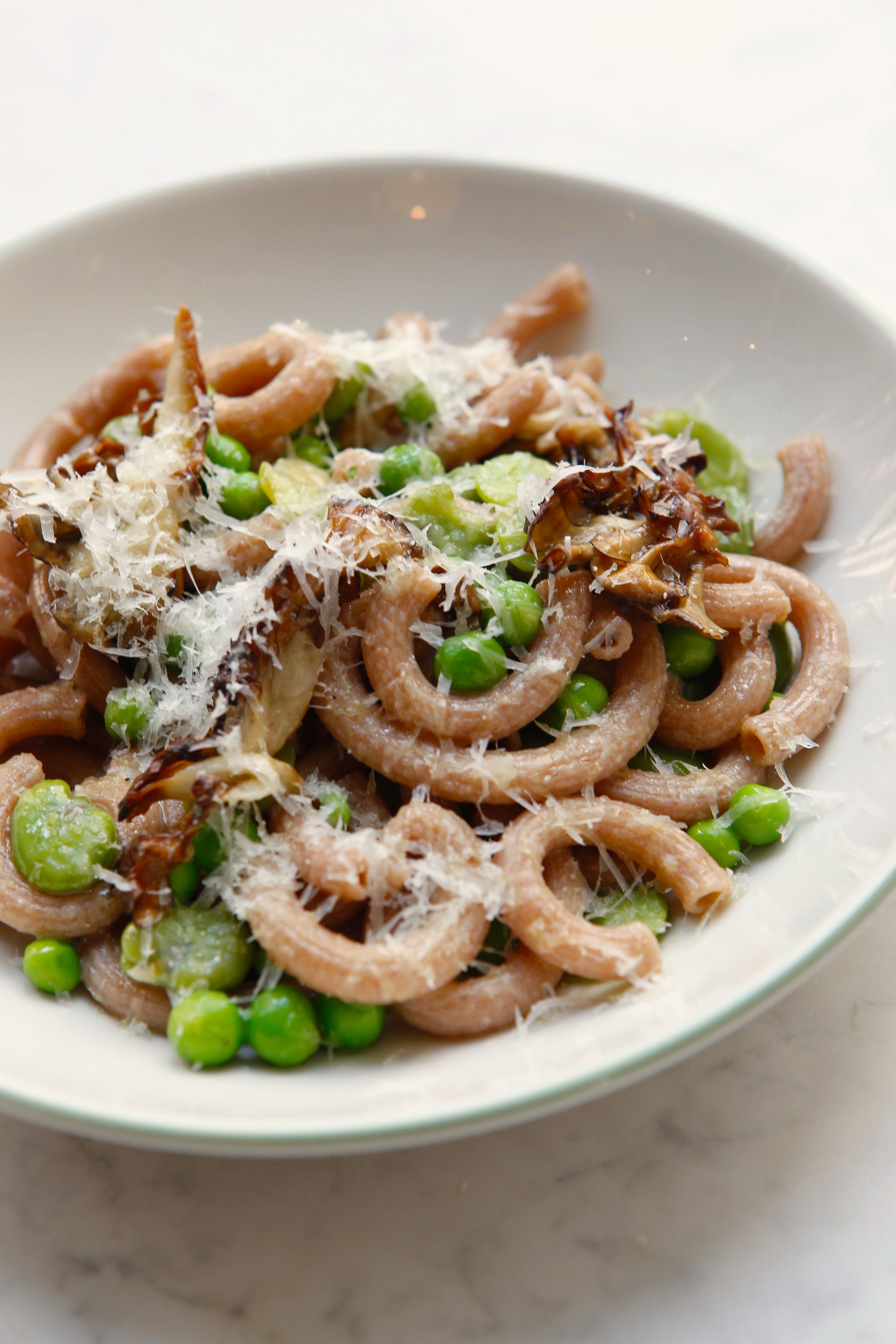 likely to
be found in trattorias in Lucca and Viareggio than
in Naples or New York. The pasta for this dish,
like all of them at La Pecora Bianca, is handmade
by Chef Simone Bonelli (below, right) , who once worked
with the hyper-creative Massimo Buttura at Osteria
Francescana in Modena. There is spelt strozzapreti
(“priest stranglers”) with hot and spicy ‘nduja
sausage spread and equally spicy arrabiata
sauce ($16); einkorn wheat goes into curly gramigna
pasta with pork sausage, garlic, chili flakes and
broccolini ($17);
red fife, a Canadian wheat, made into
ribbons of tagliatelle
come with
a lusty beef and pork bolognese sauce ($16). Not
only do these pastas on their own have a distinct
chewiness to them--perfectly al dente--but
they
exhibit their own particular flavors and textures. The
risotto, made with Vialone rice, is vibrant green
with peppery pesto and bright red with a sweet
tomato reduction ($15). This is not a place to find
clichés like penne alla vodka.
likely to
be found in trattorias in Lucca and Viareggio than
in Naples or New York. The pasta for this dish,
like all of them at La Pecora Bianca, is handmade
by Chef Simone Bonelli (below, right) , who once worked
with the hyper-creative Massimo Buttura at Osteria
Francescana in Modena. There is spelt strozzapreti
(“priest stranglers”) with hot and spicy ‘nduja
sausage spread and equally spicy arrabiata
sauce ($16); einkorn wheat goes into curly gramigna
pasta with pork sausage, garlic, chili flakes and
broccolini ($17);
red fife, a Canadian wheat, made into
ribbons of tagliatelle
come with
a lusty beef and pork bolognese sauce ($16). Not
only do these pastas on their own have a distinct
chewiness to them--perfectly al dente--but
they
exhibit their own particular flavors and textures. The
risotto, made with Vialone rice, is vibrant green
with peppery pesto and bright red with a sweet
tomato reduction ($15). This is not a place to find
clichés like penne alla vodka.
Owner
Mark Barak (below), who also runs the Provençal
bistro Claudette, opened La Pecora Bianca (“white
sheep”) Caffé e Cucina on the corner of Broadway
and 26th Street, and as soon as you walk by the
large windows and look in, you will feel it is a
place you’d love to try: the lighting is good, the
décor a mix of the rustic and the sleek, with a restored
marble column and white marble espresso bar, white
marble staircase, terra cotta, oak plank floors
and tables, and a hand-painted wall tile behind
the bar and open kitchen walls. Since
this is a caffé, you can enjoy their own special
blend of coffee (they also sell the beans, as well
as jams and preserves and sheep and goat’s milk
chocolates).
Outside is a 34-seat sidewalk café.
 Opened
just last month, La Pecora Bianca teems with
people who love sharing dishes, as did my party of
four. The
place is extremely loud, I’m sorry to say, not
helped by pumping in wholly unnecessary thumping
music. Barak is host here, and he’s an ebullient
fellow, obviously delighted that his cheery little
trattoria is such an overnight hit, though I
suspect it will have long legs simply because it’s
not the same menu people can find all over town.
Opened
just last month, La Pecora Bianca teems with
people who love sharing dishes, as did my party of
four. The
place is extremely loud, I’m sorry to say, not
helped by pumping in wholly unnecessary thumping
music. Barak is host here, and he’s an ebullient
fellow, obviously delighted that his cheery little
trattoria is such an overnight hit, though I
suspect it will have long legs simply because it’s
not the same menu people can find all over town.
You can tell a lot of guests zero in on the
appetizers, perhaps the salume
selection of cheeses (four for $20), but the
really good stuff are the antipasti, like the
charred peaches, sheep’s milk ricotta, lemon zest
and hazelnuts ($12); the crudi
seafood of the day sparked by citrus ($14); the crostino toast
with ‘nduja,
stracciatella and scallion ($12), and the
eggplant with white nut pesto, honey capers,
anchovies and breadcrumbs ($14). For
some reason we received no bread at the start of
our dinner.
Main
courses number just four: a fish of the day with
smoked eggplant, wild rice and tomato confit
($26); superb seared sea scallops with summer
squash, guanciale,
a touch of mint and shallots 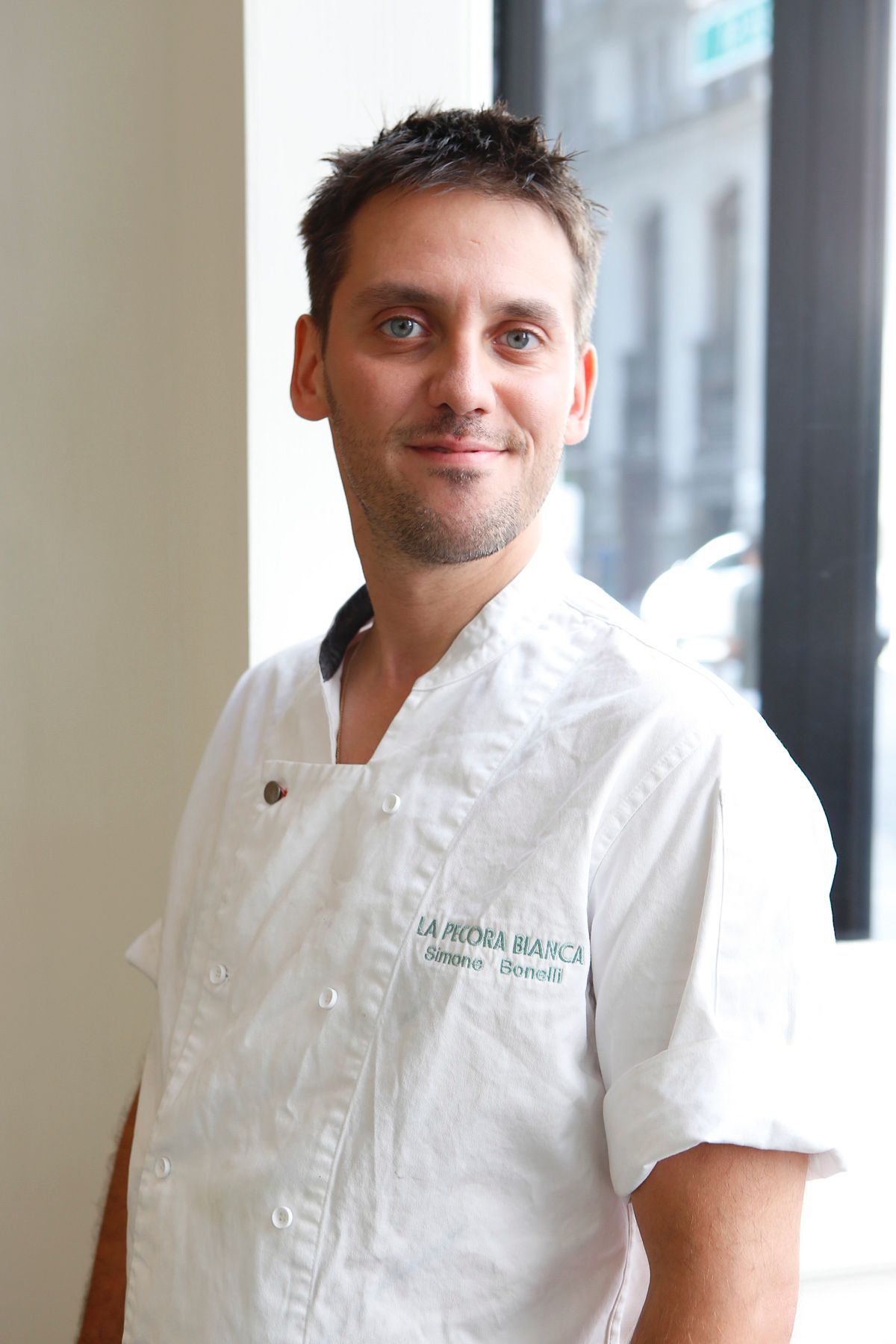 ($26); a
juicy roast chicken with mushrooms, corn, pickled
Serrano chili and red onions ($24); and a fine,
flavorful NY strip steak with spring onions,
potatoes, and cilantro-flecked chimichurri (a very
reasonable $30).
($26); a
juicy roast chicken with mushrooms, corn, pickled
Serrano chili and red onions ($24); and a fine,
flavorful NY strip steak with spring onions,
potatoes, and cilantro-flecked chimichurri (a very
reasonable $30).
The fact that there are only
two desserts on the menu--odd for a
caffe--suggests they are afterthoughts, and
neither the chocolate mousse made with goat's
milk nor the sheep's milk panna cotta
prove otherwise. The
wine and beverage lists are formidable for a place
of this size, amiably printed on two sides of a
broadsheet, as well as another list of vini della
casa you may order in 150ml, 500ml or full
bottles, with plenty of the last under $50 and
only one or two big trophy wines for those who
must show off.
But this is not that kind of place. La
Pecora Bianca, from its darling name to its
party-like ambiance, is true to Barak and Chef
Bonelli’s vision that to succeed beyond this year,
they have to offer something different to an
easily jaded crowd that often bounces from one new
place to another. Those who have eaten here once
will find that to get this kind of food, they will
have to come back again and again.
Dinner
nightly. Coffee/to-go 7am-5pm, daily
❖❖❖
By John Mariani
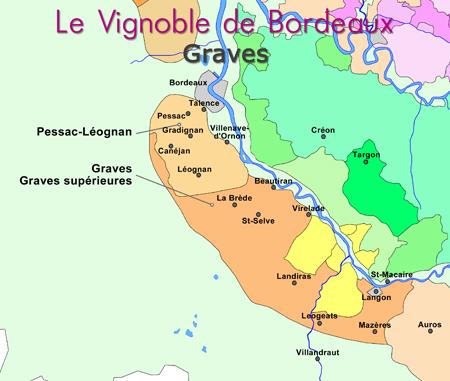 In all the years I’ve been drinking wine, I’m
always happy when someone serves me a dry
white Bordeaux. But until now I’ve rarely
bought or ordered one because too few have
given me the consistent pleasure I’ve derived
from other white wines, not least a wide array
of white Burgundies.
In all the years I’ve been drinking wine, I’m
always happy when someone serves me a dry
white Bordeaux. But until now I’ve rarely
bought or ordered one because too few have
given me the consistent pleasure I’ve derived
from other white wines, not least a wide array
of white Burgundies.
Of course, I am well aware of
the excellence of the 50/50 Sauvignon Blanc and
Sémillon blend of Haut-Brion and the 55% Semillon,
35% Sauvignon Blanc, 3% Muscadelle of La Tour-Martillac,
and the rest other regional varietals, no one
debates the unique greatness of Sauternes--all
very expensive wines. (Haut-Brion’s white runs
upwards of $400 a bottle.)
But, either through
unfamiliarity, poor distribution or pricing, the
vast majority of Bordeaux whites have in the
past showed little distinction. This,
thank heavens, is now changing rapidly. The
problem has been along northern and southern
geographic lines above and to the east of
Bordeaux, a
large sausage-shaped region that goes
under the general appellation of Graves.
In the past the better wines of Graves shared
their appellation with lesser ones in the same
region, many, as Tom Stevenson wrote in The
Sotheby’s Wine Encyclopedia, “from some of
the best properties whose winemakers either did
not know how to, or did not care to, clean up
their act as they continued to sell tired,
oversulfered, oxidized, and flabby wines on the
backs of their decaying reputation.”
This began to change in the
late 1980s, when an AOC was given specifically
to the best region within
Graves--Pessac-Léognan, whose name lifted the
category and encouraged winemakers to make
better, more long-lasting wines. I
have, then, been delighted to taste a number of
white Bordeaux recently that achieve both high
quality through attention to terroir and price
points that make them more affordable. Once
such wines were far too dry and lacked fruited
character, and, after all, grapes are
fruit.
Chȃteau
du Seuil 2012 ($29) typifies the new
approach to white Bordeaux, where gravel and
limestone dominate the soil (right). The
château is on a plateau overlooking
the Garonne River and gets the amount of sun
needed to express fruit flavors. The wine is a
blend of 70% Sémillon and 30% Sauvignon Blanc,
both aromatic varietals with a lingering finish,
and they interact well and can age very well up
to ten years, though they may lose freshness
after five.
Château
Carbonnieux 2012, with a 60% Sémillon,
40% Sauvignon mix, has a good creaminess to it,
less dry than many. The estate dates back to
the 13th century as an abbey and since 1959 has
enjoyed a Cru Classe ranking for both its reds
and whites.
It was also among the first to adopt the
Pessac-Léognan appellation as a signal to others
that they should try to improve their wines.
Carbonnieux makes organic wines that age ten
months in barrel, which gives them additional
flavors without too much oak.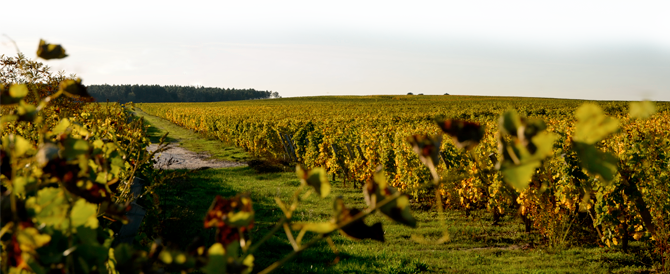 The
blend is usually about 65% Sauvignon Blanc and
35% Semillon, which gives it a somewhat more
vegetal style.
Because of its continuing reputation,
I’ve seen Carbonnieux in American wine stores go
for about $36, which may make it a little high
to bring in converts.
The
blend is usually about 65% Sauvignon Blanc and
35% Semillon, which gives it a somewhat more
vegetal style.
Because of its continuing reputation,
I’ve seen Carbonnieux in American wine stores go
for about $36, which may make it a little high
to bring in converts.
Chȃteau La Louvière
(left),
owned by the wide-ranging Bordeaux producer
André Lurton since 1965, was also an abbey at
one time.
Its reds and whites spend the same time
in barrel (12 months). Chȃteau La Louvière 2010 is a rare
100% Sauvignon Blanc that shows how splendid
that grape on its own can be, in contrast to the
grassy fruit punches of New Zealand and many
examples from California. The floral component
gives it elegance, and even though this wine is
already five years old, it has lost none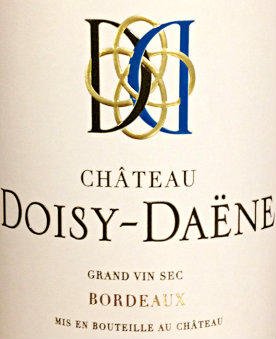 of its
pretty freshness while taking on more and more
character.
The price range varies from as little as
$26 way up to $60, so shop around.
of its
pretty freshness while taking on more and more
character.
The price range varies from as little as
$26 way up to $60, so shop around.
Chȃteau
Doisy-Daëne 2013 ($30) is a more
youthful vintage of 100% Sauvignon Blanc, which spends
eight months in barrel, 20% new oak. Better
known for its sweet Barsac, Doisy-Daëne proudly
makes this dry Grand Vin Sec to exhibit the
character of its gravelly terroir along with a
decided citrus bite that makes it a good
candidate for all shellfish right now; in a year
or two it will probably go well with oily
seafood like salmon and bluefish.
Holding on to white Bordeaux
is not so much a gamble as it is a way of
depriving yourself of the pleasure of its youth. I
would drink any as of the 2010 vintage right
now.

OR WE COULD
JUST ROLL OUR
EYES AND GROAN
“You have to
love a place whose clever logo -- street signs that read
"Main Street" and "Kitchen" -- carries the tag line, "At
the intersection of Farm and Table."-- By Jackie Burrell,
"Walnut Creek's Main Street Kitchen celebrates seasonal
fare,"
. . . AND YET
ANOTHER HEE-HAW MOMENT BROUGHT
TO YOU BY AMERICA'S LARD
LOBBY
Any of John Mariani's books below may be ordered from amazon.com.
 I'm proud and happy to announce that my
new book, The Hound
in Heaven (21st Century Lion Books), has just
been published through Amazon and Kindle.
I'm proud and happy to announce that my
new book, The Hound
in Heaven (21st Century Lion Books), has just
been published through Amazon and Kindle. It is a novella, and for anyone who loves dogs, Christmas, romance, inspiration, even the supernatural, I hope you'll find this to be a treasured favorite. The story concerns how, after a New England teacher, his wife and their two daughters adopt a stray puppy found in their barn in northern Maine, their lives seem full of promise. But when tragedy strikes, their wonderful dog Lazarus and the spirit of Christmas are the only things that may bring back his master back from the edge of despair.
WATCH THE VIDEO!
“What a huge surprise turn this story took! I was completely stunned! I truly enjoyed this book and its message.” – Actress Ali MacGraw
“He had me at Page One. The amount of heart, human insight, soul searching, and deft literary strength that John Mariani pours into this airtight novella is vertigo-inducing. Perhaps ‘wow’ would be the best comment.” – James Dalessandro, author of Bohemian Heart and 1906.
“John Mariani’s Hound in Heaven starts with a well-painted portrayal of an American family, along with the requisite dog. A surprise event flips the action of the novel and captures us for a voyage leading to a hopeful and heart-warming message. A page turning, one sitting read, it’s the perfect antidote for the winter and promotion of holiday celebration.” – Ann Pearlman, author of The Christmas Cookie Club and A Gift for my Sister.
“John Mariani’s concise, achingly beautiful novella pulls a literary rabbit out of a hat – a mash-up of the cosmic and the intimate, the tragic and the heart-warming – a Christmas tale for all ages, and all faiths. Read it to your children, read it to yourself… but read it. Early and often. Highly recommended.” – Jay Bonansinga, New York Times bestselling author of Pinkerton’s War, The Sinking of The Eastland, and The Walking Dead: The Road To Woodbury.
“Amazing things happen when you open your heart to an animal. The Hound in Heaven delivers a powerful story of healing that is forged in the spiritual relationship between a man and his best friend. The book brings a message of hope that can enrich our images of family, love, and loss.” – Dr. Barbara Royal, author of The Royal Treatment.
 |
The Encyclopedia of American Food and Drink by John F. Mariani (Bloomsbury USA, $35) Modesty forbids me to praise my own new book, but let me proudly say that it is an extensive revision of the 4th edition that appeared more than a decade ago, before locavores, molecular cuisine, modernist cuisine, the Food Network and so much more, now included. Word origins have been completely updated, as have per capita consumption and production stats. Most important, for the first time since publication in the 1980s, the book includes more than 100 biographies of Americans who have changed the way we cook, eat and drink -- from Fannie Farmer and Julia Child to Robert Mondavi and Thomas Keller. "This book is amazing! It has entries for everything from `abalone' to `zwieback,' plus more than 500 recipes for classic American dishes and drinks."--Devra First, The Boston Globe. "Much needed in any kitchen library."--Bon Appetit. |
"Eating Italian will never be the same after reading John Mariani's entertaining and savory gastronomical history of the cuisine of Italy and how it won over appetites worldwide. . . . This book is such a tasteful narrative that it will literally make you hungry for Italian food and arouse your appetite for gastronomical history."--Don Oldenburg, USA Today. "Italian
restaurants--some good, some glitzy--far
outnumber their French rivals. Many of
these establishments are zestfully described
in How Italian Food Conquered the World, an
entertaining and fact-filled chronicle by
food-and-wine correspondent John F.
Mariani."--Aram Bakshian Jr., Wall Street
Journal.
"Equal parts
history, sociology, gastronomy, and just
plain fun, How Italian Food Conquered the
World tells the captivating and delicious
story of the (let's face it) everybody's
favorite cuisine with clarity, verve and
more than one surprise."--Colman Andrews,
editorial director of The Daily
Meal.com. "A fantastic and fascinating
read, covering everything from the influence
of Venice's spice trade to the impact of
Italian immigrants in America and the
evolution of alta cucina. This book will
serve as a terrific resource to anyone
interested in the real story of Italian
food."--Mary Ann Esposito, host of PBS-TV's
Ciao
Italia. "John Mariani has written the
definitive history of how Italians won their
way into our hearts, minds, and
stomachs. It's a story of pleasure over
pomp and taste over technique."--Danny Meyer,
owner of NYC restaurants Union Square
Cafe, The Modern, and Maialino.
|
 |
 |
 |
 |
 |
 |
 |
 |
 Everett Potter's Travel Report:
Everett Potter's Travel Report: 
 Eating Las
Vegas is the new on-line site for
Virtual Gourmet contributor John A. Curtas.,
who since 1995 has been commenting on the
Las Vegas food scene and reviewing
restaurants for Nevada Public Radio.
He is also the restaurant critic for KLAS
TV, Channel 8 in Las Vegas, and his past
reviews can be accessed at KNPR.org.
Click on the logo below to go directly to
his site.
Eating Las
Vegas is the new on-line site for
Virtual Gourmet contributor John A. Curtas.,
who since 1995 has been commenting on the
Las Vegas food scene and reviewing
restaurants for Nevada Public Radio.
He is also the restaurant critic for KLAS
TV, Channel 8 in Las Vegas, and his past
reviews can be accessed at KNPR.org.
Click on the logo below to go directly to
his site.

Tennis Resorts Online: A Critical Guide to the World's Best Tennis Resorts and Tennis Camps, published by ROGER COX, who has spent more than two decades writing about tennis travel, including a 17-year stretch for Tennis magazine. He has also written for Arthur Frommer's Budget Travel, New York Magazine, Travel & Leisure, Esquire, Money, USTA Magazine, Men's Journal, and The Robb Report. He has authored two books-The World's Best Tennis Vacations (Stephen Greene Press/Viking Penguin, 1990) and The Best Places to Stay in the Rockies (Houghton Mifflin, 1992 & 1994), and the Melbourne (Australia) chapter to the Wall Street Journal Business Guide to Cities of the Pacific Rim (Fodor's Travel Guides, 1991).


MARIANI'S VIRTUAL GOURMET
NEWSLETTER is published weekly. Editor/Publisher: John
Mariani.
Editor: Walter Bagley. Contributing Writers: Christopher Mariani,
Robert Mariani, Misha
Mariani,
John A. Curtas, Edward Brivio, Mort Hochstein,
Andrew Chalk, Dotty Griffith and Brian Freedman. Contributing
Photographers: Galina Dargery, Bobby
Pirillo. Technical Advisor: Gerry McLoughlin.
To un-subscribe from this newsletter,click here.
© copyright John Mariani 2015

